Dynamic Analysis of Sphere-Like Iron Particles Based Magnetorheological Damper for Waveform-Generating Test System
Abstract
1. Introduction
2. Force-Velocity Diagram Modeling of the High Capacity Shock MR Damper
2.1. Double Pulse Waveform Shock Test Setup
2.2. Double Pulse Shock Test Results and Analysis
2.3. Damping F-V Curve Modeling
3. Waveform Prediction Simulator
3.1. Dynamic Modeling of Dual Shock Waveform: Primary Shock Waveform
3.2. Dynamic Modeling of Dual Shock Waveform: Secondary Shock Waveform
3.3. Waveform Prediction Simulator Program Structure
4. Conclusions
Author Contributions
Funding
Acknowledgments
Conflicts of Interest
References
- Rabinow, J. The magnetic fluid clutch. Electr. Eng. 1948, 67, 1167. [Google Scholar] [CrossRef]
- Rabinow, J. Magnetic Fluid Torque and Force Transmitting Device. U.S. Patent 2,575,360, 20 November 1951. [Google Scholar]
- Choi, S.B.; Han, Y.M. Magnetorheological Fluid Technology: Applications in Vehicle Systems; CRC Press: Boca Raton, FL, USA, 2012. [Google Scholar]
- De Vicente, J.; Klingenberg, D.J.; Hidalgo-Alvarez, R. Magnetorheological fluids: A review. Soft Matter 2011, 7, 3701–3710. [Google Scholar] [CrossRef]
- Kor, Y.K.; See, H. The electrorheological response of elongated particles. Rheol. Acta 2010, 49, 741–756. [Google Scholar] [CrossRef]
- De Vicente, J.; Vereda, F.; Segovia-Gutiérrez, J.P.; del Puerto Morales, M.; Hidalgo-Álvarez, R. Effect of particle shape in magnetorheology. J. Rheol. 2010, 54, 1337–1362. [Google Scholar] [CrossRef]
- Shah, K.; Oh, J.S.; Choi, S.B.; Upadhyay, R.V. Plate-like iron particles based bidisperse magnetorheological fluid. J. Appl. Phys. 2013, 114, 213904. [Google Scholar] [CrossRef]
- Jiang, Z.; Christenson, R. A comparison of 200 kN magneto-rheological damper models for use in real-time hybrid simulation pretesting. Smart Mater. Struct. 2011, 20, 065011. [Google Scholar] [CrossRef]
- Choi, S.B.; Sung, K.G. Vibration control of magnetorheological damper system subjected to parameter variations. Int. J. Veh. Des. 2008, 46, 94–110. [Google Scholar] [CrossRef]
- Lu, S.B.; Li, Y.N.; Choi, S.B.; Zheng, L.; Seong, M.S. Integrated control on MR vehicle suspension system associated with braking and steering control. Veh. Syst. Dyn. 2011, 49, 361–380. [Google Scholar] [CrossRef]
- Choi, S.-B.; Han, Y.-M. MR seat suspension for vibration control of a commercial vehicle. Int. J. Veh. Des. 2003, 31, 202–215. [Google Scholar] [CrossRef]
- Nguyen, Q.H.; Choi, S.B. Optimal design of MR shock absorber and application to vehicle suspension. Smart Mater. Struct. 2009, 18, 035012. [Google Scholar] [CrossRef]
- Nguyen, Q.H.; Choi, S.B. Optimal design of a vehicle magnetorheological damper considering the damping force and dynamic range. Smart Mater. Struct. 2008, 18, 015013. [Google Scholar] [CrossRef]
- Choi, S.B.; Li, W.; Yu, M.; Du, H.; Fu, J.; Do, P.X. State of the art of control schemes for smart systems featuring magneto-rheological materials. Smart Mater. Struct. 2016, 25, 043001. [Google Scholar] [CrossRef]
- Choi, Y.T.; Wereley, N.M. Vibration control of a landing gear system featuring electrorheological/magnetorheological fluids. J. Aircr. 2003, 40, 432–439. [Google Scholar] [CrossRef]
- Han, C.; Kim, B.G.; Choi, S.B. Design of a New Magnetorheological Damper Based on Passive Oleo-Pneumatic Landing Gear. J. Aircr. 2018, 55, 2510–2520. [Google Scholar] [CrossRef]
- Seong, M.S.; Choi, S.B.; Kim, C.H. Design and performance evaluation of MR damper for integrated isolation mount. J. Intell. Mater. Syst. Struct. 2011, 22, 1729–1738. [Google Scholar] [CrossRef]
- Han, C.; Choi, S.B.; Lee, Y.S.; Kim, H.T.; Kim, C.H. A new hybrid mount actuator consisting of air spring and magneto-rheological damper for vibration control of a heavy precision stage. Sens. Actuators A Phys. 2018, 284, 42–51. [Google Scholar] [CrossRef]
- Kim, H.C.; Oh, J.S.; Choi, S.B. The field-dependent shock profiles of a magnetorhelogical damper due to high impact: An experimental investigation. Smart Mater. Struct. 2014, 24, 025008. [Google Scholar] [CrossRef]
- Zhaodong, W.; Yu, W.; Lei, Z.; Jianye, D. Modeling and dynamic simulation of novel dual-wave shock test machine. In Proceedings of the 2011 International Conference on Fluid Power and Mechatronics, Beijing, China, 17–20 August 2011; IEEE: Piscataway, NJ, USA, 2011; pp. 898–901. [Google Scholar]
- Wang, G.; Xiong, Y.; Tang, W. A novel heavy-weight shock test machine for simulating underwater explosive shock environment: Mathematical modeling and mechanism analysis. Int. J. Mech. Sci. 2013, 77, 239–248. [Google Scholar] [CrossRef]
- Kim, T.H.; Shul, C.W.; Yang, M.S.; Lee, G.S. An analytic investigation on the implementation method for required signal of heavy weight shock test machine. In Proceedings of the Korean Society of Mechanical enginees, Annual Spring/Fall Conference, Gwangju, Korea, 11–14 November 2014; KSME: Seoul, Korea, 2014; pp. 400–405. [Google Scholar]
- Shul, C.W.; Kim, T.H.; Yang, M.S.; Lee, G.S. Development of large-scale heavy weight shock testing system. In Proceedings of the Korean Society of Mechanical enginees, Annual Spring/Fall Conference, Gwangju, Korea, 11–14 November 2014; KSME: Seoul, Korea, 2014; pp. 377–382. [Google Scholar]
- Kang, M.S.; Shul, C.W.; Kim, T.H.; Yang, M.S.; Song, W.K.; Lee, G.S. A design of large and heavy dual shock generation system. In Proceedings of the Korean Society of Mechanical enginees, Annual Spring/Fall Conference, Gwangju, Korea, 11–14 November 2014; KSME: Seoul, Korea, 2014; pp. 383–388. [Google Scholar]
- Chnstiansen, M. Under Water Explosive Shock testing (UNDEX) of a subsea mateable electrical connector, the CM2000. In MTS/IEEE Oceans 2001. An Ocean Odyssey. Conference Proceedings (IEEE Cat. No. 01CH37295); IEEE: Piscataway, NJ, USA, 2001; pp. 661–666. [Google Scholar]
- Demir, M.E.; Çalışkan, M. Shock Analysis of an Antenna Structure Subjected to Underwater Explosions. 2015. Available online: http://etd.lib.metu.edu.tr/upload/12619172/index.pdf (accessed on 9 February 2020).
- Kwon, S.H.; Na, S.M.; Flatau, A.B.; Choi, H.J. Fe–Ga alloy based magnetorheological fluid and its viscoelastic characteristics. J. Ind. Eng. Chem. 2020, 82, 433–438. [Google Scholar] [CrossRef]
- Wu, J.; Hu, H.; Li, Q.; Wang, S.; Liang, J. Simulation and experimental investigation of a multi-pole multi-layer magnetorheological brake with superimposed magnetic fields. Mechatronics 2020, 65, 102314. [Google Scholar] [CrossRef]
- Bica, I.; Anitas, E.M.; Chirigiu, L.; Daniela, C.; Chirigiu, L.M.E. Hybrid magnetorheological suspension: Effects of magnetic field on the relative dielectric permittivity and viscosity. Colloid Polym. Sci. 2018, 296, 1373–1378. [Google Scholar] [CrossRef]
- Bica, I.; Anitas, E.M.; Lu, Q.; Choi, H.J. Effect of magnetic field intensity and γ-Fe2O3 nanoparticle additive on electrical conductivity and viscosity of magnetorheological carbonyl iron suspension-based membranes. Smart Mater. Struct. 2018, 27, 095021. [Google Scholar] [CrossRef]

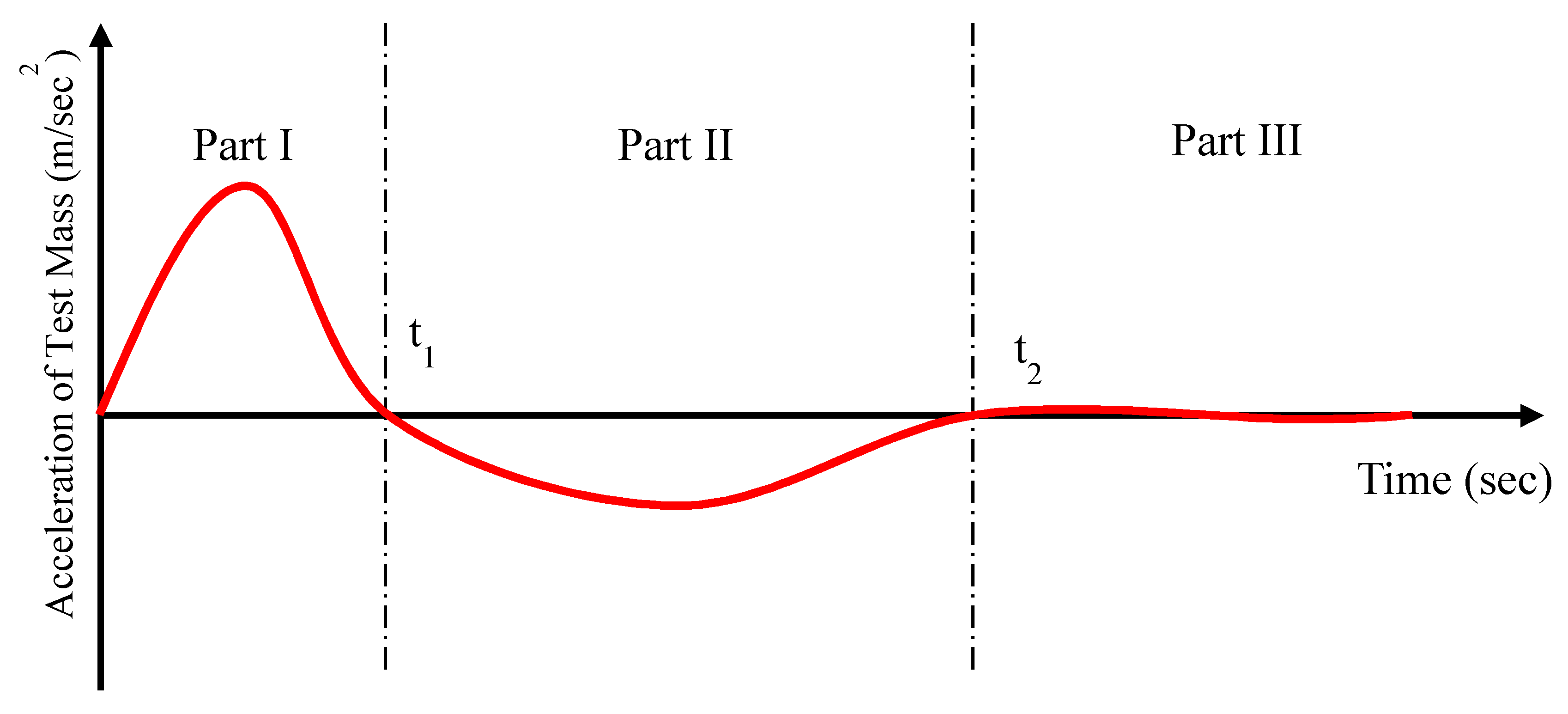
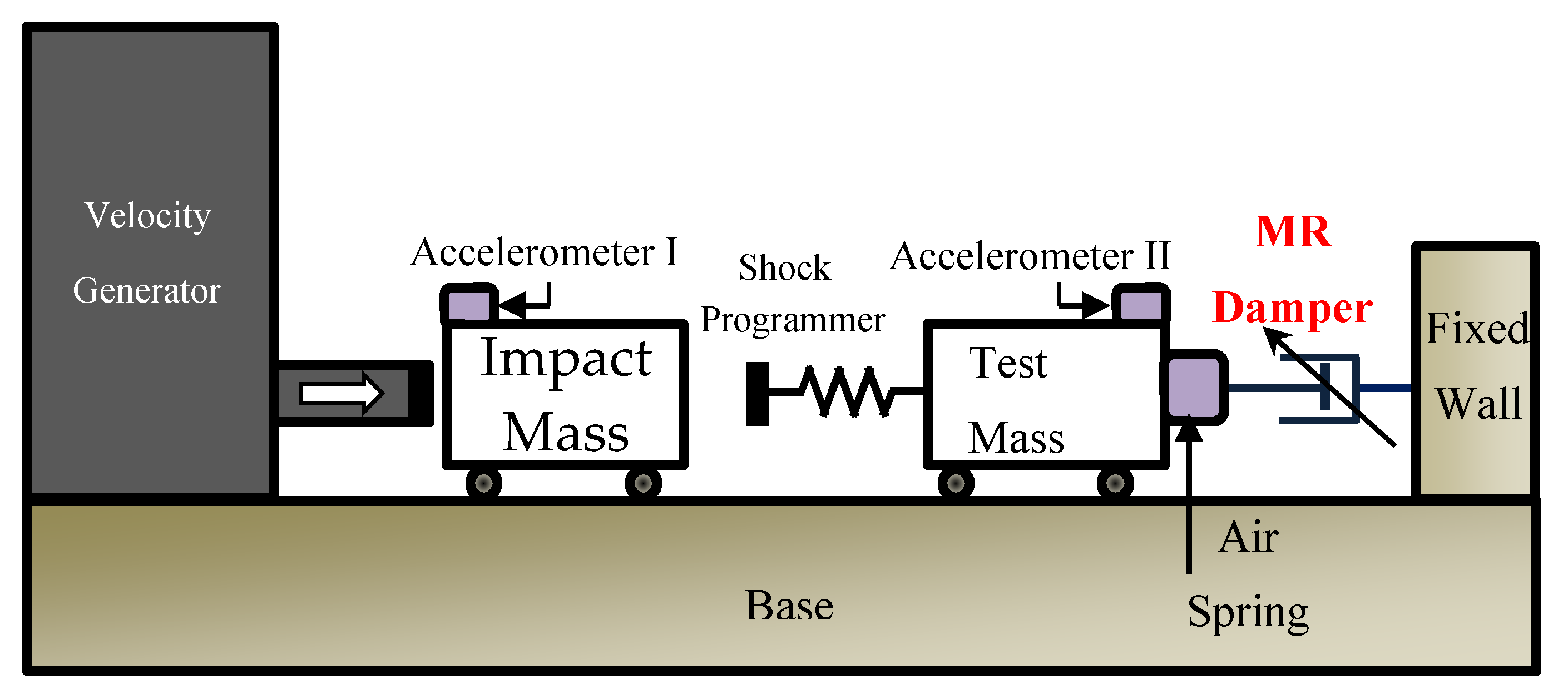
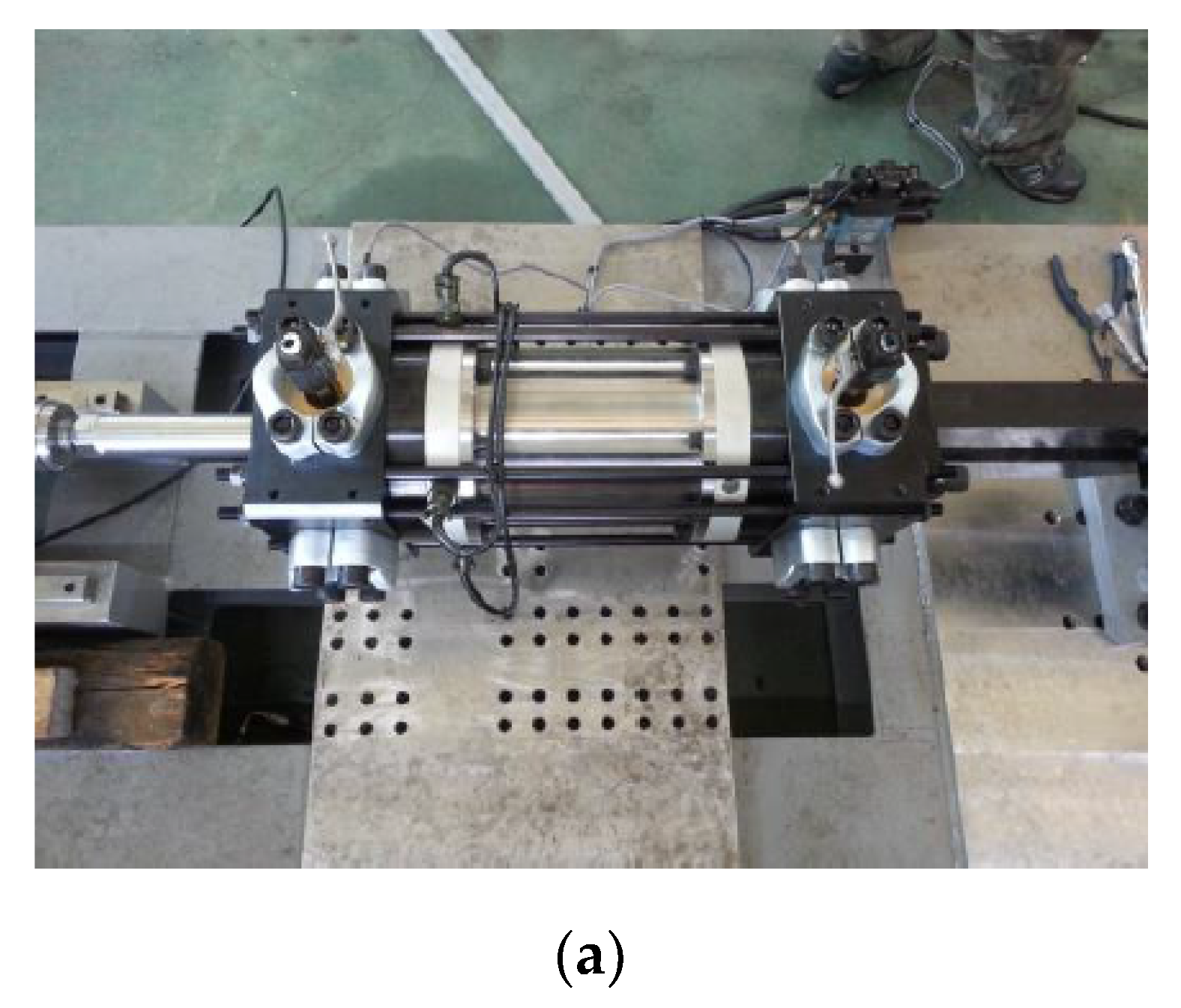
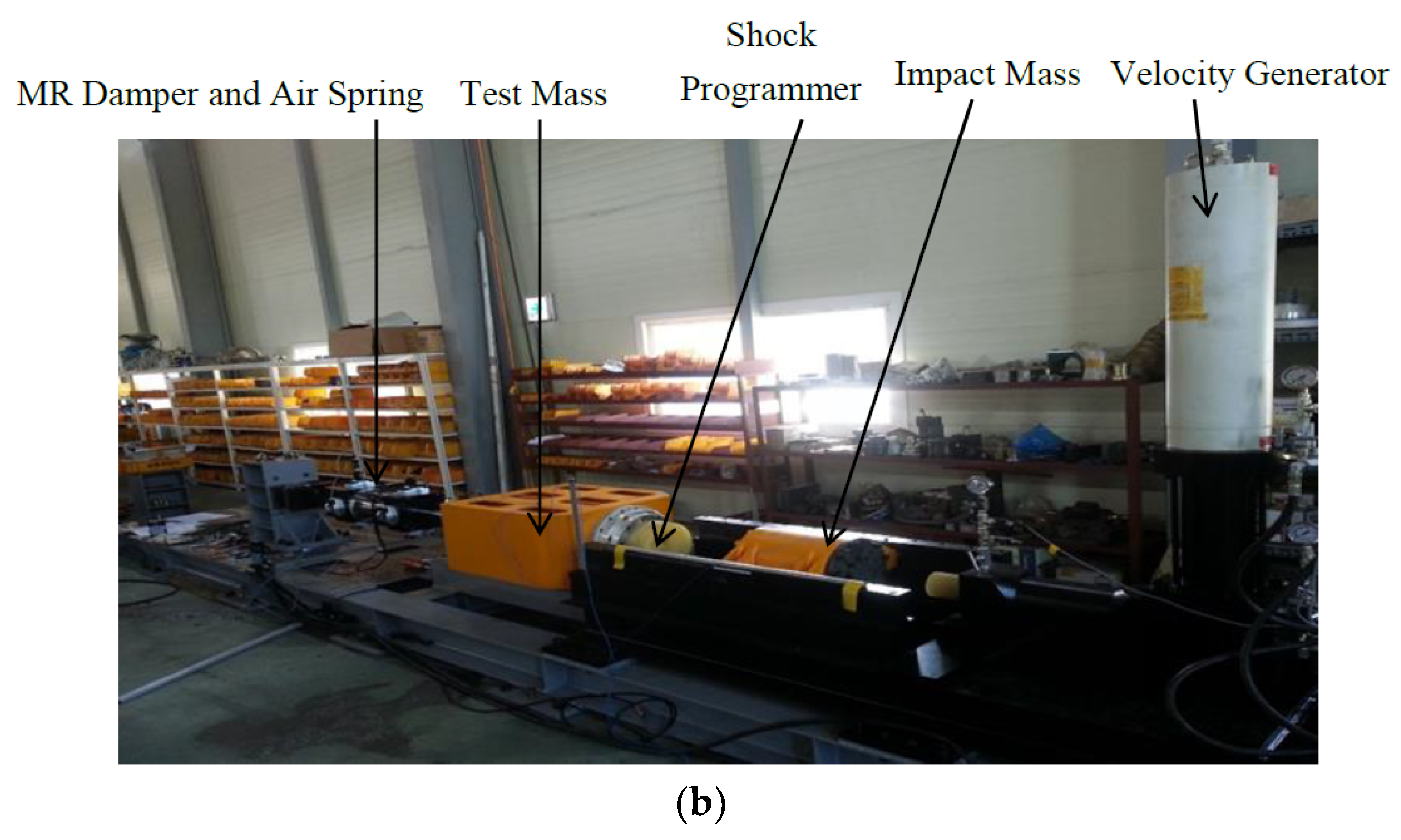
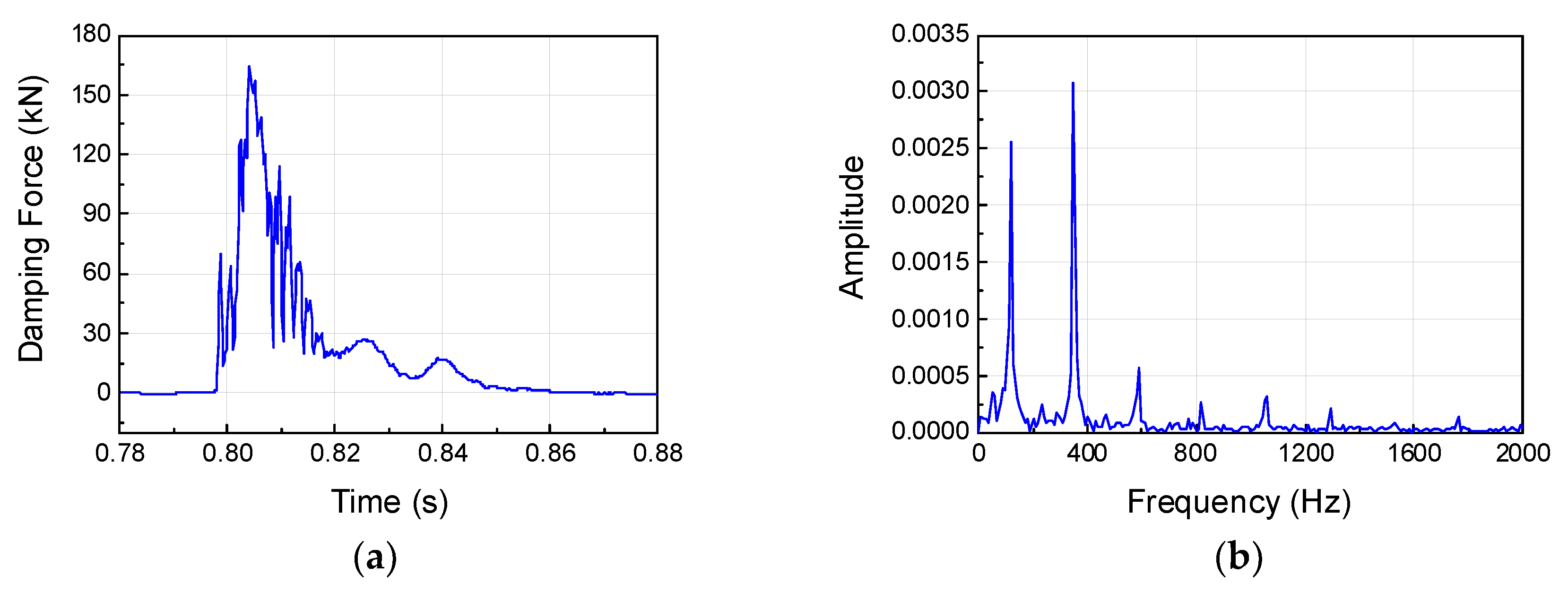




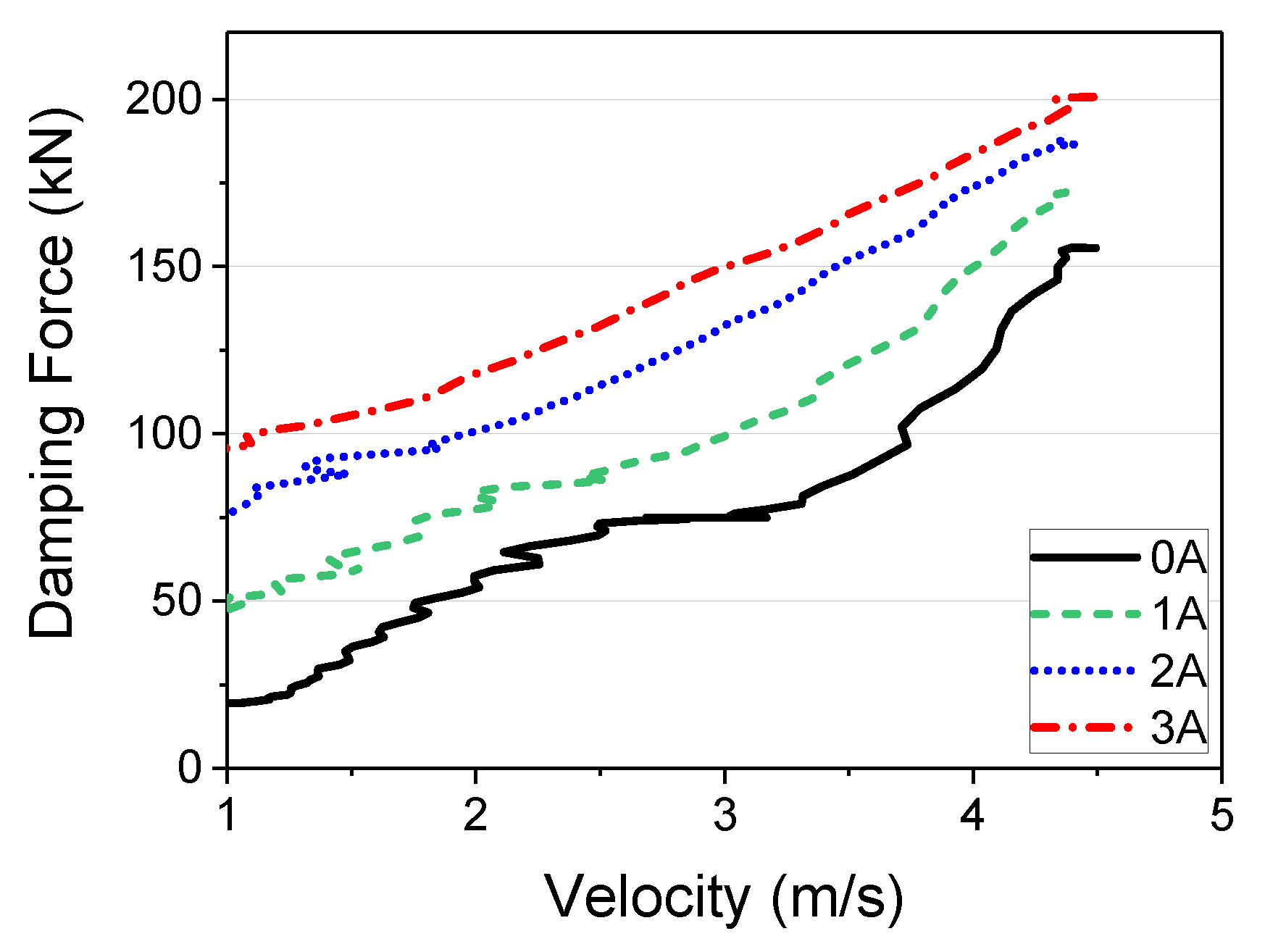
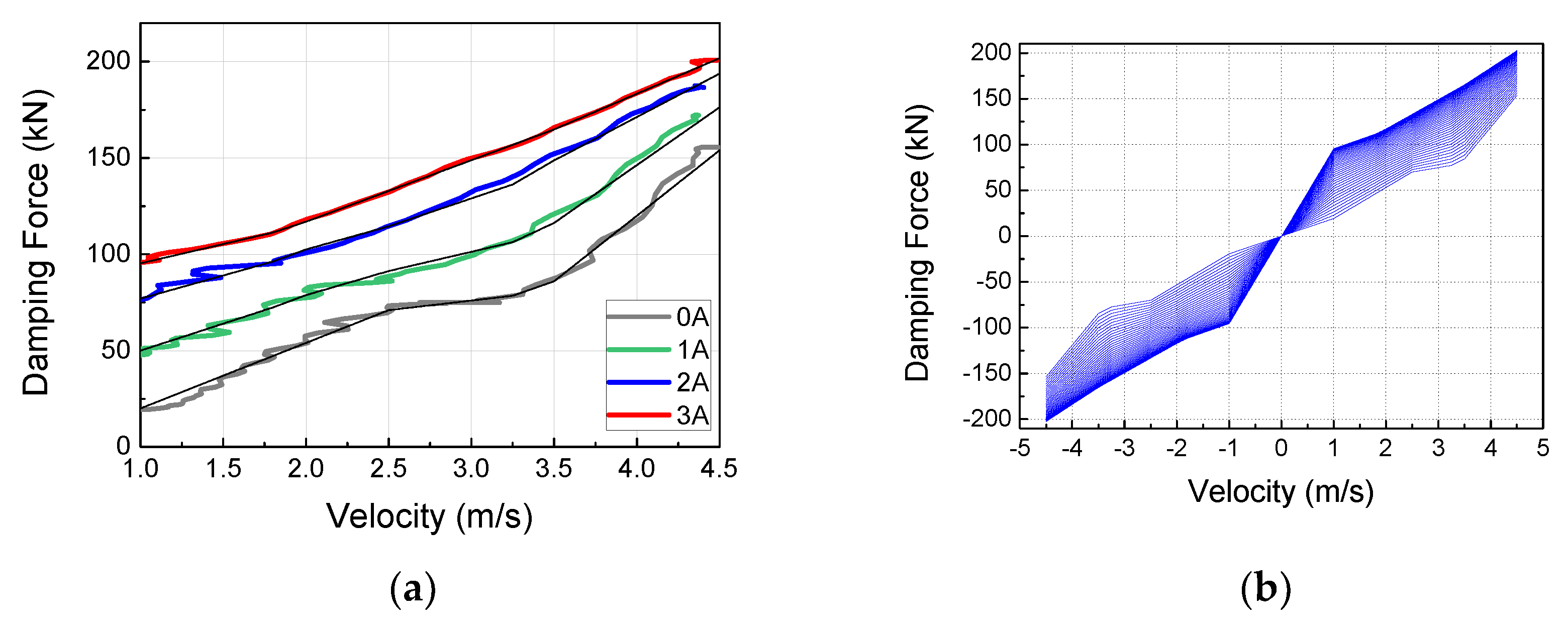

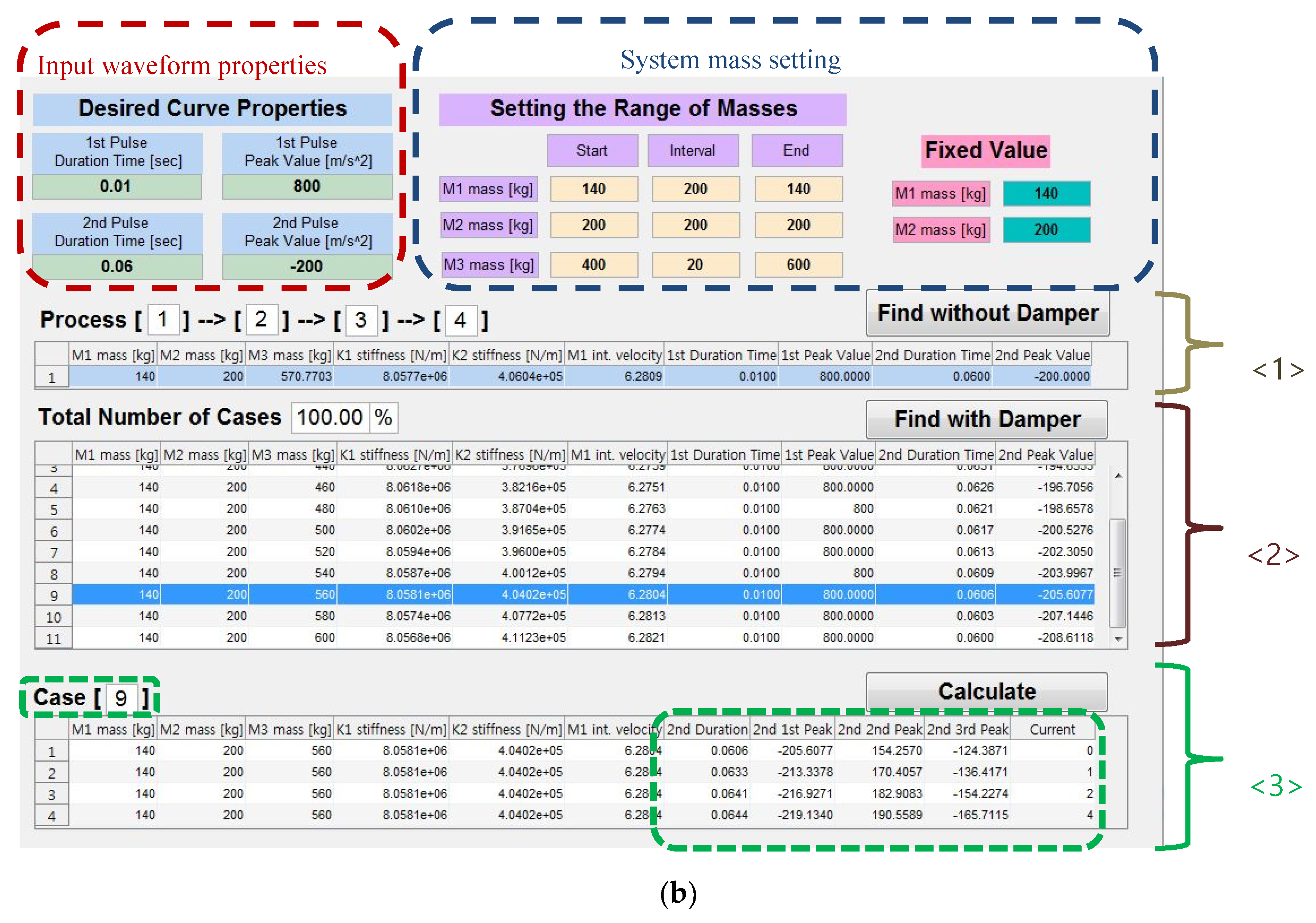
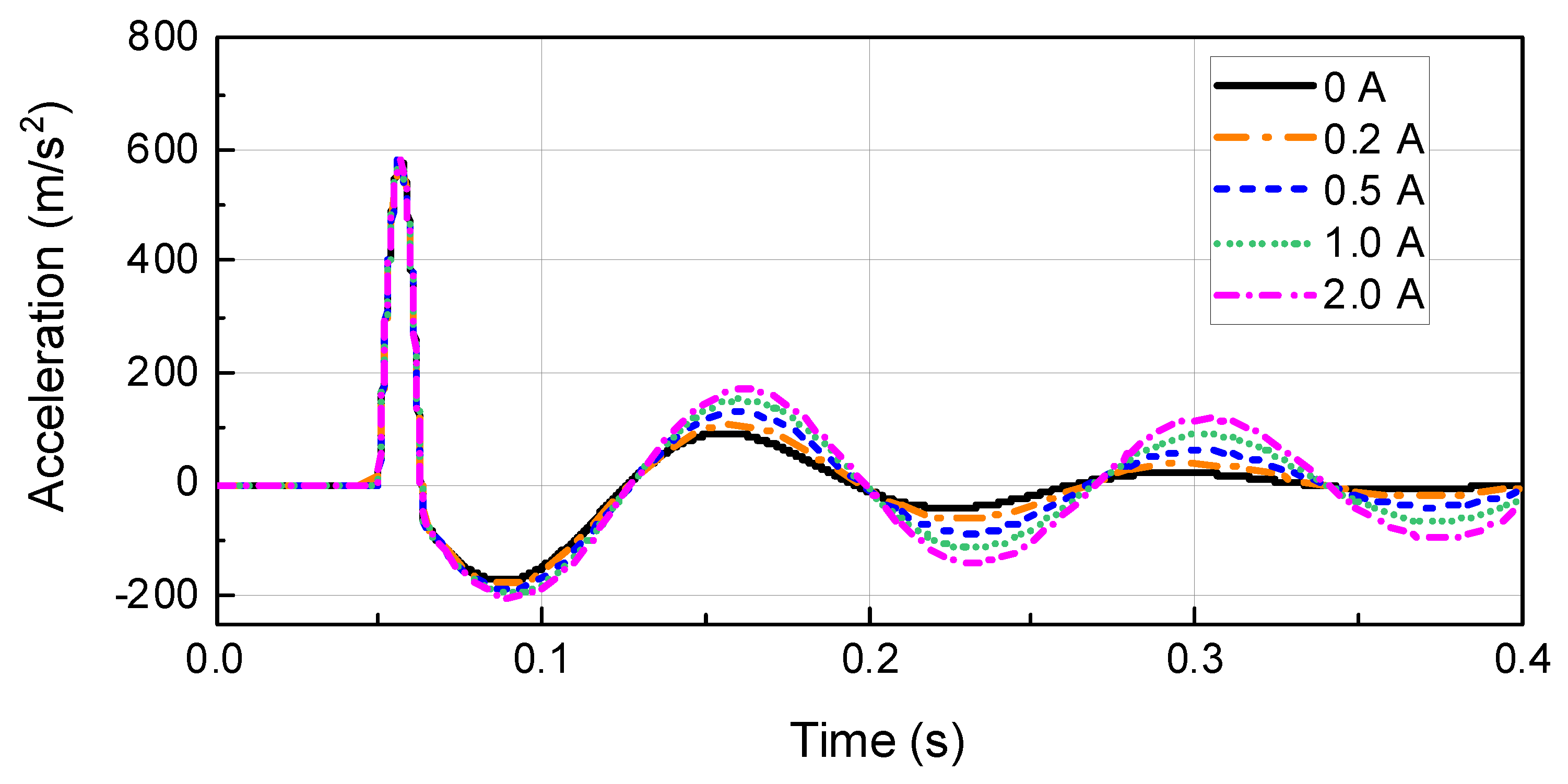

| Test No. | Impact Force at Test Table | Damping Force | Max. Velocity of Piston | Dynamic Range of Damping Force | |
|---|---|---|---|---|---|
| Max. | Min. | ||||
| 1 | 108.208 kN | 84.0 kN | 48.9 kN | 1.5 m/s | 1.72 |
| 2 | 183.708 kN | 144.0 kN | 97.9 kN | 2.75 m/s | 1.47 |
| 3 | 246.678 kN | 177.7 kN | 132.5 kN | 4.2 m/s | 1.341 |
| 4 | 301.194 kN | 201.3 kN | 150.7 kN | 4.4 m/s | 1.336 |
| Vel. [m/s] | ||
|---|---|---|
| ~0.0–1.0 | −0.4534 i 2 + 3.7204 i + 1.9272 | 0 |
| ~1.0–1.8 | 0.0773 i 2 – 0.6573 i + 3.3945 | −0.4534 i 2 + 3.7204 i + 1.9272 |
| ~1.8–2.0 | −0.0045 i 2 + 0.1255 i + 3.3809 | −0.3916 i 2 + 3.1946 i + 4.6428 |
| ~2.0–2.5 | −0.0586 i 3 + 0.5758 i2 – 1.4175 i + 1.9272 | −0.3925 i 2 + 3.1675 i + 5.319 |
| ~2.5–3.25 | −0.187 i 2 + 1.3076 i + 0.9671 | −0.2724 i 2 + 2.6697 i +6.9998 |
| ~3.25–3.5 | −0.4325 i 2 + 1.813 i + 2.8962 | −0.4127 i 2 + 3.6504 i + 7.7252 |
| ~3.5–4.5 | 0.1386 i 2 – 1.3686 i + 6.9173 | −0.5208 i 2 + 4.1037 i + 8.4492 |
| >4.5 | 2 | −0.3822 i 2 + 2.7351 i + 15.366 |
© 2020 by the authors. Licensee MDPI, Basel, Switzerland. This article is an open access article distributed under the terms and conditions of the Creative Commons Attribution (CC BY) license (http://creativecommons.org/licenses/by/4.0/).
Share and Cite
Oh, J.-S.; Shul, C.W.; Kim, T.H.; Lee, T.-H.; Son, S.-W.; Choi, S.-B. Dynamic Analysis of Sphere-Like Iron Particles Based Magnetorheological Damper for Waveform-Generating Test System. Int. J. Mol. Sci. 2020, 21, 1149. https://doi.org/10.3390/ijms21031149
Oh J-S, Shul CW, Kim TH, Lee T-H, Son S-W, Choi S-B. Dynamic Analysis of Sphere-Like Iron Particles Based Magnetorheological Damper for Waveform-Generating Test System. International Journal of Molecular Sciences. 2020; 21(3):1149. https://doi.org/10.3390/ijms21031149
Chicago/Turabian StyleOh, Jong-Seok, Chang Won Shul, Tae Hyeong Kim, Tae-Hoon Lee, Sung-Wan Son, and Seung-Bok Choi. 2020. "Dynamic Analysis of Sphere-Like Iron Particles Based Magnetorheological Damper for Waveform-Generating Test System" International Journal of Molecular Sciences 21, no. 3: 1149. https://doi.org/10.3390/ijms21031149
APA StyleOh, J.-S., Shul, C. W., Kim, T. H., Lee, T.-H., Son, S.-W., & Choi, S.-B. (2020). Dynamic Analysis of Sphere-Like Iron Particles Based Magnetorheological Damper for Waveform-Generating Test System. International Journal of Molecular Sciences, 21(3), 1149. https://doi.org/10.3390/ijms21031149







